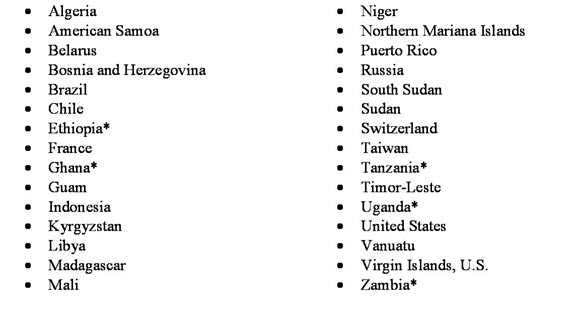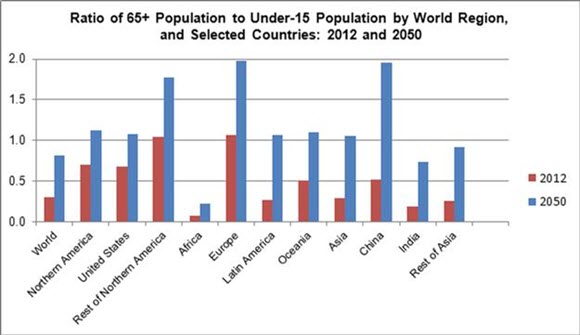Census Bureau Releases Demographic Estimates and Projections for Countries of the World
Census Bureau Releases Demographic Estimates and Projections for Countries of the World
How large is the population of the world’s newest country? When will India overtake China as most populous country? Is the world growing younger or older? The latest update of the U.S. Census Bureau’s International Data Base (IDB) has answers to these and many more questions. The IDB — a leading source of demographic information on the Internet — has been updated with new projections of population, births, deaths, international migrants, and the impact of HIV/AIDS for 30 countries and areas of the world:
* Data for these countries have undergone additional analyses to update the estimated effects of HIV/AIDS. See:
The current update of the IDB includes the newest country in the world — South Sudan. South Sudan, which achieved full independence from Sudan on July 9, 2011, had a mid-2012 population of about 10.6 million. In addition, the estimates and projections for France have been revised to include Mayotte, which on March 31, 2011, became an overseas department of France.
The IDB’s projections indicate a bit of shuffling among the ranks of the top 10 countries in the world by population size from 2012 to 2050. Japan is the only country slated to drop off the list by 2025, with Ethiopia replacing it as the10th most populous (131 million). Russia will drop out of the top 10 by 2050, with the Philippines assuming the 10th spot (172 million). India is expected to overtake China for the top spot in 2025 and is projected to remain in the top spot in 2050 as well. The United States will maintain its rank position of third from 2012 to 2050. China and India are each expected to have nearly 1.4 billion inhabitants in 2025 — more than the next five countries on the list combined, and India’s current pace of growth will have it reaching nearly 1.7 billion people by 2050.
| Changing World and Regional Age Composition: 2012 to 2050 | |||
|---|---|---|---|
Percentage of population |
Ratio of population 65+ to population under 15 |
||
| World region | 0-14 |
65+ |
|
| 2012 | |||
| World | 25.2 |
7.8 |
0.31 |
| Northern America | 19.6 |
13.8 |
0.71 |
| United States | 20.0 |
13.5 |
0.68 |
| Rest of Northern America | 15.6 |
16.3 |
1.05 |
| Africa | 40.9 |
3.4 |
0.08 |
| Europe | 15.5 |
16.6 |
1.07 |
| Latin America | 26.7 |
7.1 |
0.27 |
| Oceania | 22.7 |
11.6 |
0.51 |
| Asia | 24.8 |
7.3 |
0.29 |
| China | 17.4 |
9.1 |
0.52 |
| India | 29.3 |
5.6 |
0.19 |
| Rest of Asia | 23.3 |
6.4 |
0.27 |
| 2050 | |||
| World | 20.5 |
16.7 |
0.82 |
| Northern America | 18.7 |
21.1 |
1.13 |
| United States | 19.1 |
20.5 |
1.08 |
| Rest of Northern America | 14.8 |
26.3 |
1.77 |
| Africa | 30.1 |
6.7 |
0.22 |
| Europe | 14.1 |
27.9 |
1.98 |
| Latin America | 17.6 |
18.8 |
1.07 |
| Oceania | 17.6 |
19.5 |
1.11 |
| Asia | 17.8 |
18.8 |
1.05 |
| China | 13.7 |
26.8 |
1.95 |
| India | 19.8 |
14.7 |
0.74 |
| Rest of Asia | 18.8 |
17.2 |
0.82 |
The IDB does not just cover the most populous places in the world; it provides estimates and projections for 228 countries and areas that have at least 5,000 people. At the bottom of the population-size list, the IDB indicates that by 2025, Montserrat’s projected population of 5,529 will have surpassed that of Saint Pierre and Miquelon (population: 5,030) for the next-to-last spot on the list.
The world’s 7 billion inhabitants in 2012 are an older mix of people than was the case a decade ago, driven by declining fertility and increasing life expectancy. Between now and the middle of the 21st Century, global population will continue aging – the percentage of population ages 65 and above will more than double, from 8 percent today to nearly 17 percent in 2050. For more detailed information about the health-related implications of global aging, see Shades of Gray: A Cross-Country Study of Health and Well-Being of the Older Populations in SAGE Countries, 2007-2010.
The IDB provides projected populations by single years of age for all countries through 2050. For a general description of how the Census Bureau’s estimates and projections are developed, see:








